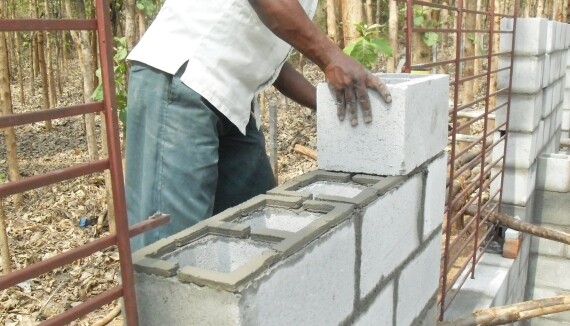Engineers, site managers, and quantity surveyors are always faced with the challenge of specifying as accurately as possible, the quantity of materials needed to execute a specific item of work. In this article, we are going to explain how you can estimate the quantity of mortar (cement and sand) needed to lay blocks per square metre of wall.
It is well known that we need about 10 blocks to build one square metre of wall.
Simple Proof;
Area of wall = 1 m2
Planar area of one standard block (Nigeria) = 450mm x 225mm = 101250 mm2 = 0.10125 m2
Therefore, the number of blocks required (disregarding mortar) = 1/0.10125 = 9.87 (say 10 blocks)
Now, how do we estimate the quantity of mortar needed to lay the blocks? First of all, let us look at the dimensions of a typical 9 inches block with holes (the most popular block for building in Nigeria).
From the image of the sandcrete, we can say that the cross-sectional area of the block that receives horizontal mortar is;
Ab = (0.45 x 0.225) – 2(0.15 x 0.125) = 0.0637 m2
Now, let us assume that the mortar will be 25 mm (1 inch) thick.
The typical arrangement of blocks in a one square metre wall is shown below;
Therefore, we can estimate the volume of mortar required to build one square metre (1 m2) of wall as follows;
Vertical mortar = 8 x (0.025 x 0.225 x 0.275) = 0.0123 m3
Horizontal mortar = 10 x (0.0637 x 0.025) = 0.0159 m3
Total = 0.0282 m3
Therefore the volume of mortar required to lay one square metre (1 m2) of 9-inch block (with holes) can be taken as 0.03 m3 for all practical purposes.
Cement requirement
The typical mix ratio for mortar (laying of blocks) is 1:6
Quantity of cement required = 1/7 x 1440 kg/m3 = 205.71 kg
Making allowance for shrinkage between fresh and wet concrete = 1.54 x 205.71 = 316.79 kg
Quantity of cement required in bags = 316.79/50 = 6.33 bags/m3 of mortar
Therefore, the quantity of cement required to lay 1m2 of wall = 0.03 × 6.33 = 0.1899 bags
If 0.1899 bags of cement = 10 blocks
Therefore, 1 bag of cement = 52 blocks
Therefore, 1 bag of cement is required to lay 52 blocks using a 1:6 mix ratio of mortar.
Sand
Quantity of sand required = 6/7 x 1600 kg/m3 = 1371.428 kg
Making allowance for shrinkage between fresh and wet concrete = 1.54 x 1371.428 = 2112 kg
Quantity of sand required in tonnes = 2.112 tonnes/m3 of mortar
Therefore, the quantity of sand for mortar required to lay 1m2 of wall = 0.03 × 2.112 = 0.06336 tonnes of sand
If 0.06336 tonnes of sand = 10 blocks
Therefore, 1 tonne of sand = 157 blocks
Therefore, 1 tonne (1000 kg) of sand is required to lay 157 blocks using a 1:6 mix ratio of mortar.
Further Example
To go further, let us assume that we have 150 m2 (about 1500 blocks) of wall and want to estimate the quantity of cement and sand needed to lay the blocks.
The volume of mortar required = 0.03 x 150 = 4.5 m3
For 4.5m3 of mortar;
Provide = 4.5 x 6.33 = 29 bags of cement
For 4.5m3 of mortar;
Provide = 4.5 x 2112 = 9504 kg of sharp sand
Therefore you need about 10 tonnes of sharp sand and 29 bags of cement for laying 150m2 of 9 inches block wall.
Thank you for visiting Structville today, and God bless.











Nice post.
Dry volume = 1.54 x Wet volume for concrete
Dry volume = 1.35 x Wet volume for mortar please confirm a lot of arguments on this
This is an awesome one bro.
It makes sense but truth still remains that no one will accept that on site.
The site standard we know is that 1 bag of cement should lay about 50 blocks. This calculation basically confirms that.
No client will accept this, this is one of the problems of Engineering in Nigeria. Your estimation is according to standard, but that's only for Company Jobs where a workman is entitled to just 70 blocks per day.
No common man will accept this, before you know it, one person that doesn't even know standard will come and quote nonsense.
Kudos bro
Good job Brother. I truly love your analysis. It’s practically correct and applicable in sites in Nigeria.
Let’s check to see if this is possible.
By your calculation, 29 bags of cement is required to build 150m² wall. It’s true because in 150m² we have 1500 blocks, since the area of one block is 0.10m².
Now dividing 1500 by 29 the answer is 51 block. It means 1 bag of cement can build 51 block which to Me its ok!
But my question is, for 1m² you gave 8 vertical portions of mortal and 10 for horizontal. For horizontal, I have no problem since there 10 blocks per square metre. But for vertical is there a formula that relate?
God bless you greatly Sir.
Sir what abt for 6” blocks the volume of square metre required
Nice Content Thanks for sharing .. BIM documentation in India
BIM Consulting in India
cad services in India
BIM Solutions in India
BIM Project Management in India
I think this calculation does not take into account the practical application.
If 1 bag of cement is to be mixed with 12 head pans of sand.
32 bags of cement will be mixed with 384 head pans of sand. Using the 1: 6.
Now you said for 32 bags, 10 tonnes of sand should be ordered, 10 tonnes of sand is 40 wheel barrow, i.e 160 head pans of sand.
That’s my view, I want you to shed more light on this.
Thanks.
Hi Raheem,
Look at it this way. Our basic calculation was 9504 kg of sand and 29 bags of cement (that is 1450 kg of cement).
Density = Mass/Volume
For sand; 1600 = 9504/Volume (Hence volume of sand = 5.94 cumecs)
For cement; 1440 = 1450/Volume (Hence volume of cement = 0.99 cumecs)
Therefore, you can see that the ratio of 1:6 is in order. Kindly confirm that 10 tonnes of sand is equal to 40 wheelbarrows.
This is because the volume of 10 tonnes of sand is 6.25 cumecs
The volume of a standard builder’s wheel barrow = 0.065 cumecs
Therefore, there are about 96 unheaped wheelbarrows in 10 tonnes of sand, which is 384 headpans of sand.
So I think we are very much in order.
Kindly look at the calculation again. I think there is a problem. If 4.5m3 is required to lay 150m2 of 225mm blocks, I think to calculate the cement and sand contents should be
Cement 1/7×4.5=0.643m3 x 1440=925.92kg/50kg= 18.5bags
Sand 6/7×4.5=3.857m3 x 1450=5592.65kg
Approximately one bag of cement lays 80 blocks.
Thanks
I tend to agree with your calculation
Hi Adewunmi,
Remember that I applied a factor of 1.54 to account for shrinkage between fresh and dry and mortar, and you didn’t do that. That is just the difference in our result.
What abt calculations for 6inches block for laying
Thank you for this suitable article about how to calculate the quantity of mortar for laying blocks, it will help me and people like me looking for the same. I appreciate your effort for taking time to do your research and present these details before us. Really nice way to present this content, very appreciative!!
Well presented analysis. Very helpful.
I thank you for work well done
Engr. I’m upcoming Engr, I really appreciate all your analysis and is so inspiring, May God continued inspiring you with much wisdom, please still keep updating us nice job and practical, thanks Sir.
Pls Engr Ubanni, what about a 5 inch solid block?
How can I calculate the quantity of cement and mortar
you did not fill the voids with mortar? kindly double check please. I was wondering why’d you used 0.025 instead of 0.125.
Bro, this is total gibberish, take it down. How now?
29 bags of cement to lay 10 blocks. Haba
Can you let us know where you got that from?
WHAT ABOUT SOLID BLOCK NOT HOLLOW
Don’t you think it would have been better if the number of blocks per square meter was assumed considering mortal since all other calculations that followed are all based on that (number of blocks/SM)?
Engr Ranks, you’re doing well. God bless you
Thanks so much it was so helpful to me
Sorry for coming late sir, but my issue is with the 0.275 vertical height, 8(0.025*0.225*0.275), how did you arrive on that figure? please get back to me so as to enable me conclude my project.
please can someone explain to me how the value for the vertical height (0.275)came about i.e 8(0.025 * 0.225 * 0.275)
please can someone explain to me how the value for the vertical height (0.275)came about i.e 8(0.025 * 0.225 * 0.275)